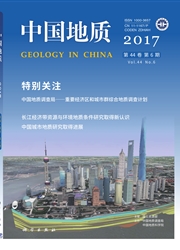

 中文摘要:
中文摘要:
为研究中国北方陆相盆地红层-黑色岩系对砂岩型铀成矿的制约,文章研究了国内外红-黑岩系与砂岩型铀矿赋存岩层的时空关系,筛选了10万余m岩心钻探资料,选择准噶尔、鄂尔多斯和松辽盆地这3个典型产铀盆地,通过编制盆地钻孔柱状图、典型地区连井剖面图及关键岩层的地球化学测试等方法,对红-黑岩系和砂岩型铀矿的赋存岩层进行了垂向、横向上综合分析与对比。研究发现:北方陆相盆地自西向东铀矿赋存地层的时代由中侏罗世过渡到晚白垩世;晚中生代至少存在6次大规模的富氧红层沉积事件:I中侏罗世—晚侏罗世早期(Bathonian-Oxfordian),II早白垩世早中期(Berriasian-Barremian),III早白垩世中期(Barremian),IV晚白垩世早期(Cenomanian),V晚白垩世中期(Coniacian)和VI晚白垩世晚期(Campanian)。其中第I、V和VI期红层之下沉积了时代相近的黑色层,与之构成“红-黑岩系”的沉积结构,是北方砂岩型铀成矿的3个重要层位。典型盆地内地球化学表明,红层与黑色层的B、Sr和Cu元素含量及Fe2+/Fe3+、B/Ga、Sr/Cu和FeO/MnO比值具有明显的差异,结合黑色岩层中草莓状黄铁矿、碳屑、油斑和红层中碳酸盐岩的发育,认为红层为相对较强氧化环境,黑色层为相对较还原环境。连井剖面资料显示红层、黑色层与砂岩型铀矿空间关系密切,铀矿多产于红层与黑色层之间过渡带上,呈板状矿体赋存于灰色、绿灰色砂岩和细砂岩中。一般红层与黑色层垂向距离超过500m不利于成矿。晚中生代陆相盆地内耦合产出的黑色岩系和红色岩系是古沉积环境由还原向氧化转变形成的垂向分带,前者为铀矿物质沉淀提供了“障”,后者为表生流体溶解铀矿提供了“场”。文章初步提出了红-黑岩系垂向环境变化制约着北方陆相盆地砂岩型铀大规模成矿作用的新认?
 英文摘要:
英文摘要:
Based on the973program and the northern sandstone type uranium survey program,this study tried to explain the“red and black”sandstone constraint on uranium mineralization.On the basis of summarizing temporal and spatial relationship between red layers and black layers of global sandstone uranium deposits and the sieving of more than100,000meters core drilling data of the northern continental basin,the authors selected Junggar,Ordos and Songliao basin as typical research objects.Through compilation of drilling chart of the basin,investigating well-connecting section of typical mining area and geochemical testing of key strata,the authors made a vertical and horizontal comprehensive analysis and comparison of“red and black”sandstone and uranium-bearing strata,and the results show that the formation ages of uranium-bearing strata gradually change from Middle Jurassic to Upper Cretaceous from west to east in China.There were at least6large-scale oxygen-rich red sedimentary events in Late Mesozoic period,which are respectively I.Middle Jurassic-late Jurassic early stage(Bathonian?Oxfordian),II.Early-middle stage of the Early Cretaceous(Berriasian-Barremian),III.Middle stage of Early Cretaceous(Barremian),IV.Late stage of middle Cretaceous(Cenomanian),V.Middle stage of late Cretaceous(Coniacian),and VI.Late stage of late Cretaceous(Campanian).The red layer and the black layer below constituting“red-black color structure"in I,V and VI stage are3important uraniumbearing strata in China.Geochemical and fossil data of the red and black layers in the typical basins show that the content of B,Sr and Cu and the ratios of Fe2+/Fe3+,B/Ga,Sr/Cu and FeO/MnO are obviously different between them.The content of Fe2O3in the red layer is obviously higher,and the ratio of U and U/Th in the transition zone is obviously higher than other sides.Combined with development of strawberry pyrite in black layer and carbonate rocks in red layer,the authors hold that the red layer is a relatively strong oxidizing environment and the bla
 同期刊论文项目
同期刊论文项目
 同项目期刊论文
同项目期刊论文
 期刊信息
期刊信息
